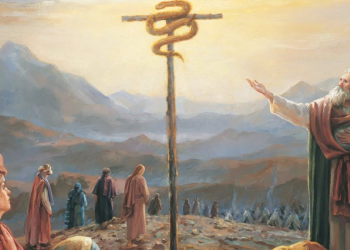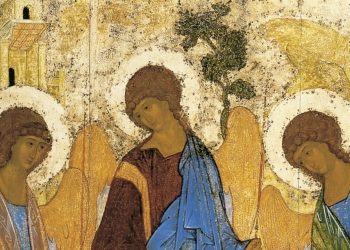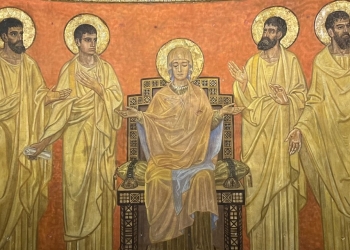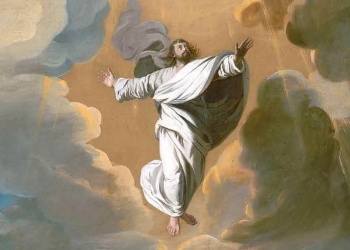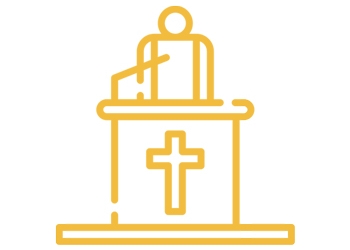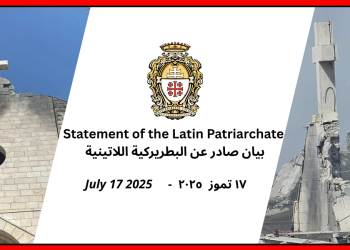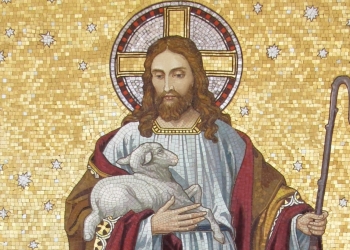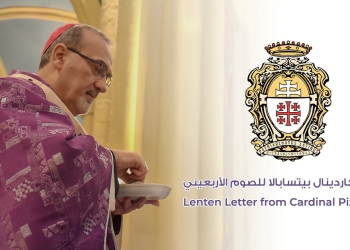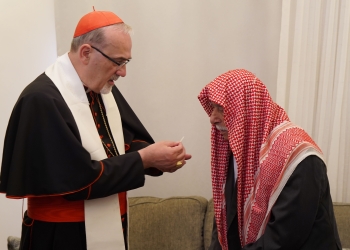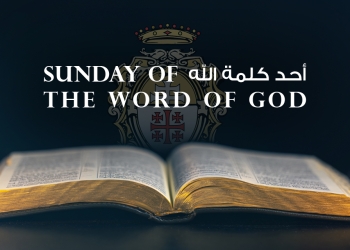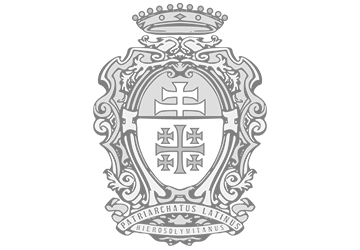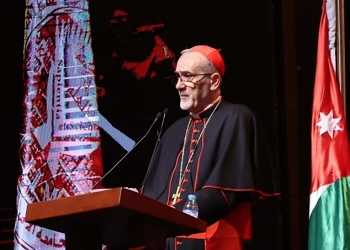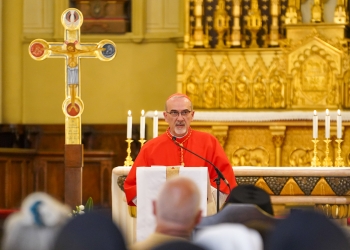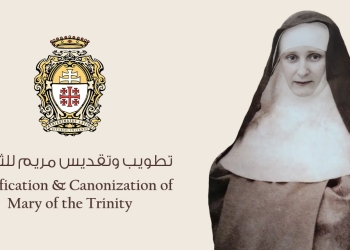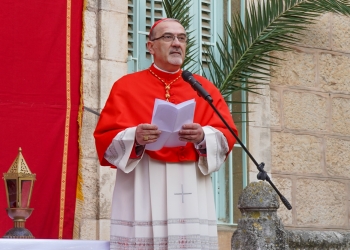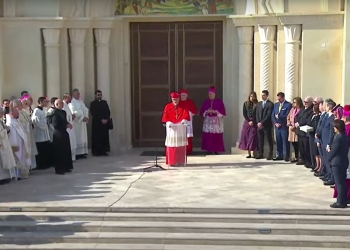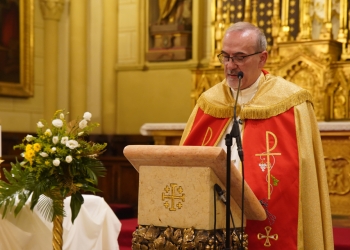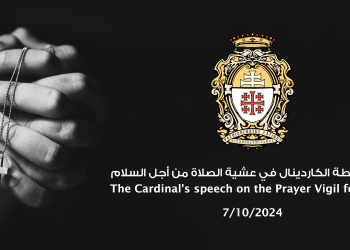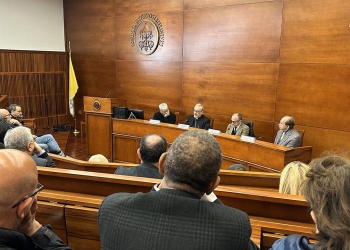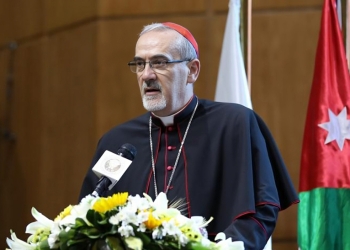Jerusalem, locus of the soul
A mother who educates and makes us grow
Article for the book presented in the context of the project” Global Compact”, in Rome.
1. Introduction
Many are talking about Jerusalem in these days. Certainly, the political aspect is predominant, linked to the Israeli-Palestinian conflict and to the various proposals that are periodically presented concerning the future of the city, loved by all and, at the same time, and perhaps for this very reason, contested by all.
Perspectives on the Holy City coming from the international community are not lacking. Initiatives from around the world concerning Jerusalem are innumerable, whether from a political point of view or a religious one. Many are invited to speak on various panels and to participate in public discussions on this issue, a sign of growing interest. Of course, there is no lack of religious references, inevitable when it comes to speaking about Jerusalem.
Furthermore, the phenomenon of population migration and the fact that throughout the world populations with different cultures and faiths are increasingly mixed and connected with each other, makes the need to deepen interreligious dialogue and give it real content more and more urgent. Religious-based conflicts current in the world today make this need a pressing one.
Precisely for this reason, speaking of interreligious dialogue and encounter among peoples, one cannot fail to think of Jerusalem, three times Holy City, the heart of revelation for Jewish, Christian and Muslim believers, inhabited by Israelis and Palestinians, loved, desired and contested by both.
In Jerusalem, religious arguments are intertwined with political perspectives coming from both Israelis and Palestinians. Their political strategies for the Holy City, in fact, are founded on their respective religious narratives about the city.
The religious links of both Jews and Muslims with the city are often translated by the respective political parties - Israeli and Palestinian - into precise choices, linked to the concrete life of the city, its borders and above all its Holy Places. Each side seeks to politically express their sovereignty over the city or at least over a portion of it, especially the part where their Holy Places are located, witnesses to their history of faith, which, however, is also a history of a people and a national identity. Precisely for this reason, the political and religious tensions in the city are always very high, sensitivities delicate and fragile and reactions excessive. Touching a particular place, altering its borders, asserting one’s sovereignty over a part of the city, seen as a necessity, is a way of fixing one’s own religious claims in the territory which, as we said, are also national and therefore political claims. The affirmation of one party’s history, however, expressed concretely in the territory of one side, is also seen as the negation of the other party, which in turn feels cheated out of its own history and national identity. In other words, the affirmation of one is seen as the negation of the other, a vicious circle out of which it is difficult to emerge.
The situation is made even more complex by the fact that in some Holy Places different or even antithetical religious narratives of Jews, Muslims and, in some cases, Christians too converge. One can take the example of the Esplanade of the Temple or the Haram al-Sharif. Two different names for the same place, where the ancient temple of Solomon and then that of Herod stood, the most sacred place for Jews. However, at the same time it is also the most sacred place, after Mecca and Medina, for Muslims, who remember there the prophet Muhammad’s ascent into heaven, becoming home of one of the most important and ancient mosques in the world. Or take the current Mount Zion, where three different narratives coexist in the same place: the cenotaph of King David, known as the Tomb of King David for the Jews, the Christian Upper Room (Cenacle) that preserves the memory of the Last Supper and the washing of the feet, as well as the memory of the Prophet Daoud (King David) for Muslims. The intertwining, therefore, of political sovereignty, of divergent religious narratives, of different national identities, of Holy Places overlapping each other, makes the life of the city very complex. Balances are very fragile, always at risk of tipping over.
Regarding all this, Christians have a different approach. The Christian perspective, in fact, keeps the religious sphere distinct from the political one. There is no claim for Christian political sovereignty over the city. Palestinian Christians stand in solidarity with the Palestinians and identify with the Palestinian perspective. In turn, Israeli Christians tend to share their country's perspective.
Christians have only a religious and spiritual claim to the city. The fact that Christians politically identify themselves with their own people, does not mean that there is no Christian interest in the city though. Yet, it is not for believers in Christ to determine who, how and under what conditions the city should be governed; but it is certainly our right and duty to express our judgment regarding the character that the city must maintain: universal, multicultural, open and in solidarity, a common patrimony and not an exclusive monopoly of any party. Alongside the Jewish and Muslim one, there is also a Christian narrative about the city, in which one finds the main Christian Holy Places, witnesses to the central events in the life of Jesus. It is precisely derived from this that Christians do sense a call to politics and involvement with the two peoples who live there, calling to respect the open and pluriform character of the city. Likewise, the Christian community never ceases to call on the international community to intervene and guarantee this open and universal character. We believe, in fact, that Jerusalem, because of its history and the supreme symbolic value it has in the lives of billions of believers in the world, should be considered the patrimony of all and a formula must be found in order to manage this city, one that respects this sacred and universal character.
This is not the place to enter into historical and religious disputes about the city. This brief and very perfunctory introduction seeks only to help the reader understand the enormous complexity of the Holy City and how difficult it is to extricate oneself from this complicated thorn bush of narratives, religions, sentiments, politics and peoples.
I have been asked to briefly present the historical and prophetic role of the city and how dialogue, despite everything, continues to be a living reality, which persists full of life, and must be sought out. It is the hidden treasure that is discovered only if you search for it.
Initially, therefore, I will try to explain why the city is so important to the believers of the three monotheistic faiths. It will be a superficial and short presentation, the intent of which is only to show the attachment of the three faiths to the city. Finally, I will try to present the concrete ways of coexistence and dialogue among the inhabitants of this city, full of fascinating contradictions.
2. Jerusalem: Between story and prophecy
Judaism, Christianity and Islam have two elements in common: firstly, faith in a single God and his revelation; secondly, the fact that the one God, Father of all, has revealed himself to humanity. Although expressed in different forms, the adherents of the three faiths believe that the one and only God has spoken, revealing himself and that this revelation is historical and verifiable.
Of course, each of these claims can be subjected to serious criticism. However, apart from the diverse evaluations of each faith and the clear and significant differences among them, here I am only interested in underlining how for all three monotheistic religions, faith is linked to a revelation, to a story and to a book. For Jews and Christians, it begins with Abraham and runs throughout the Old Testament. For Christians, history continues with Jesus and the primitive Christian community and its writings. In Islam, it is linked to the prophet Muhammad, to the revelation he received, collected in the Quran.
If there is a story, there must also be a geography. If there is an event, there must also be a place. Without place, there is no event. A banality, perhaps, but it is the basis of the real and concrete life of all three monotheistic faiths.
For this reason, Muslims go to Mecca at least once in a lifetime. This is why – focusing on Jerusalem - the pilgrimage and the bond with the mosque esplanade known as the Noble Sanctuary, the Haram al-Sharif, is so important for them.
For this same reason, Christians take care of the Holy Places, which have witnessed biblical revelation and, in particular, the life of Jesus. These two elements (history and geography) are necessary for one another. Eliminating one of the two elements means denying the event itself. It has always been essential for the Church not only to look to Jerusalem as a spiritual call, but to remain in it also physically. It is characteristic for the life of the Church to say: “He is not here; for he has been raised, as he said. Come, see the place where he lay” (Mt 28:6).
From the beginning, the Christian community gathered in places in order to remember. Remembering is not a simple reminder of a past event. That event is what still feeds Christian life today. The resurrection of Christ is the current foundation of our life of faith. We still need to run today to see the empty tomb of Christ, a way to experience the encounter with the risen one. For this reason, it is necessary for us to stay in these places, to nurture the actuality of that event. Jerusalem is the heart of this principle.
A similar kind of discourse would also be true for the people of Israel.
In Judaism, one cannot distinguish between faith in God, belonging to the people and being connected with the land. In Judaism, the land, and especially Jerusalem, has always been an essential part of the experience of faith, even during the two thousand years of Diaspora. There is no prayer without remembering the Holy City. After the establishment of the state of Israel, this spiritual and historical link has also become political. The state of Israel is considered the homeland for Jews all over the world, is the home that must protect and safeguard the unity of the people of the covenant, its security and identity.
It is, therefore, among the tasks of the Jewish state to express concretely, in forms possible today, the link with the land and above all with the Holy Places of its religious and national identity. The consequences that this entails on the political level will be examined below.
We are not talking therefore of sophisticated devotion, but rather of a need inherent to the very nature of the three faiths. The experience of faith cannot remain fixed only in memory but, in order that it might be transmitted to future generations, it needs to be remembered in writings and stones:
“Then Jacob woke from his sleep and said, "Surely the Lord is in this place-- and I did not know it!" And he was afraid, and said, "How awesome is this place! This is none other than the house of God, and this is the gate of heaven." So, Jacob rose early in the morning, and he took the stone that he had put under his head and set it up for a pillar and poured oil on the top of it. He called that place Bethel” (Gn 28:16-19).
If the Holy Land in general is the place of revelation and concretely expresses the link between God and humanity, Jerusalem is its heart. This is where the promises were focused. This is why the expectations, desires and aspirations of all believers converge in it.
What happened in Jerusalem, throughout the history of revelation and in particular for Christian believers, the events of the life of Jesus, speak of the desire for reconciliation between God and humanity and the unity of humankind (it would be enough to think of Christian Pentecost). For this reason, for all believers and in particular for Christians, Jerusalem is the symbolic place of aspiration for reconciliation and unity. Therefore, conflict and divisions in Jerusalem evoke greater bewilderment than anywhere else in the world.
Briefly, for many centuries, especially after the Crusader period, when Jerusalem was no longer at the center of political litigation, the disputes were limited to the religious sphere. There were disputes among the three faiths and, in the Christian context, among the different Christian Churches, in particular between the Orthodox and the Catholic Churches. There was no issue of political sovereignty over the city, but rather of sovereignty over the Holy Places. City life revolved around the Holy Places. Religious activity in these Places established the rhythm of life of the city and its pulse.
Jews sought to have as much access as possible to the Western Wall, which was not easily guaranteed by the Islamic authorities at the time. Christians, after the fall of the Latin Crusader Kingdom, tried to recover the Holy Places of redemption and to reestablish a minimal ecclesial structure. At the same time, the struggles among the different Churches began, struggling to ensure the exclusive possession of the Holy Places, which were gradually being recovered. The struggles led to the current situation of division in some of the main Christian Holy Places. These tensions are now part of the past and relationships are cordial today. However, these situations have unfortunately left a residue in the collective memory of the city, a legacy made up of suspicion, acquired rights, situations which are obsolete yet difficult to modify, all on display for the pilgrim and visitor who arrives in Jerusalem.
Muslims, under the long period of Ottoman rule, were dominant players in the religious life of the city and were able to consolidate broadly their historical, cultural and religious links with the city. Their historical link with the city began already with the rise of Islam and was gradually consolidated, above all - as has been stated - in the Turkish period.
Relations among the religious institutions were tense. However, the inhabitants of the city, Jews, Christians and Muslims, Arabs and non-Arabs, were brought together by the shared life in Jerusalem. Relationships among them were determined by the character of the person rather than by the diversity of religious affiliations. There could be tensions or friendships, meetings or clashes, but these were based on personal attitudes. Politics did not play much of a part in all this.
Today it is no longer so. The Christian Churches are ever closer to one another and the disputes over the Holy Places are limited to a few specific cases, which, however, do not have much influence on the real life of the Christian communities. Today, Christians are mixed together due to intermarriage. Christians as Christian (as distinct from Christians as Palestinians) do not constitute a party in the political dispute over the city. This is the preserve of Jews and Muslims. As was said initially, the attachment to the Holy Places and to the Holy City, linked to deep religious motivation, finds expression today in the political choices of the authorities of the two respective peoples, Israeli and Palestinian, being a source of perennial political and social tension.
All in all, the Palestinians (if one excludes the more extremist fringes) have a fairly unified view of Jerusalem.
The Palestinian vision for Jerusalem is one of a shared city, the capital of two states and three monotheistic faiths. It is considered essential for the Palestinians to have Jerusalem as their capital. They consider the Old City, home to almost all the Holy Places, a unity to be preserved in its integrity. Palestinians still refer to the various international UN resolutions, to the principles of the Madrid Conference and to the various initiatives of the Arab League even if today all this seems to be a legacy of the past and no longer relevant, due to recent international political initiatives and facts created on the ground that make them seem obsolete. The Palestinian leadership continues to claim these rights and to demand Israeli withdrawal from the Arab part of the city.
The Israelis, on the other hand, consider Jerusalem their capital, one and indivisible, and try to give flesh to this idea by extending their sovereignty over the entire city. The links between Judaism and Jerusalem are unique and strong, as has already been said, and this has to be recognized. If one cannot conceive of a Palestinian entity without Jerusalem, the same must be said of Israel. From a religious point of view, there is no Judaism without Jerusalem as it constantly remembers and celebrates the Holy City. However, within the Israeli leadership there are differences of opinions on the future of the city, in particular on the type of sharing possible with the Palestinians in the city of Jerusalem. I have no intention of going into the various details of the dispute, which are not within my competence. These different positions, however, clearly show that the situation today is one of conflict.
Israelis and Palestinians, even if this is not for the immediate future, should reach an agreement that somehow corresponds to their particular legitimate and reasonable aspirations and respects the principles of justice, with the collaboration of all those who can help them.
Furthermore, a solution of the territorial dispute alone is not enough for Jerusalem, precisely because Jerusalem is an unparalleled reality: it is part of the heritage of the whole world. The world-at-large in the past has shown that it is fully aware of this when, for example, through United Nations’ resolutions, it has tried to defend that heritage. Today, the international community is unfortunately almost completely absent.
The historical and material characteristics of the city, as well as its religious and cultural characteristics, must be preserved. There must be equality of rights and treatment for those who belong to the communities of the three religions present in the city, within the context of the freedom of spiritual, cultural, civic and economic activities. The Holy Places located in the city must be preserved and the rights of freedom of religion and worship and of access must be protected both for residents and for pilgrims, from the Holy Land itself and from other parts of the world.
Although at present it seems impossible that this could happen in the short term, it is clear that sooner or later the two sides will have to meet and discuss this subject, which remains the most important topic of all. Furthermore, it is clear that the two parties will have to find common criteria of reference for the definition of an agreement. It is here, that we, as Christians, must have a say. As there is no Christian political claim on the city, Christians run the risk of not being taken into consideration and not having a voice.
From our point of view, we want to insist on the need to preserve the Christian character of the city as one of the building blocks of its universal configuration. Jerusalem would lose its universality if it did not maintain its Christian character, visible and public.
By Christian character, what is meant is the possibility of praying publicly in the city. In this city there is no European bashfulness. Muslims pray publicly. Jews stop everything on Saturday. Christians must be able to do the same, according to their diverse traditions. What is also meant is support for the various Christian institutions (schools, hospitals, etc.); support for the Christian presence and its natural demographic development; the preservation of the natural ties between Jerusalem and its neighboring cities. Without these ties to the neighboring cities, and in particular Bethlehem, it would be difficult to support the different Christian institutions of the city.
The identity of the city includes a sacred character which belongs not only to individual sites or monuments, as if these could be separated from each other or isolated from their respective communities. The sacred character implies Jerusalem in its entirety, its Holy Places and its communities, with their schools, hospitals, cultural, social and economic activities. Israelis and Palestinians, in seeking a political solution to their conflict over Jerusalem, cannot overlook the fact that the city has aspects that go far beyond their legitimate national interests. Therefore, they must take these aspects into consideration in seeking and achieving a lasting political and territorial solution.
In particular, the two parties will have to ensure that the current universal character of Jerusalem is preserved and that Jerusalem continues to be the place where Jews, Muslims and Christians continue to cross paths in the streets of the Holy City, each with their own intent and their traditions, so uniquely intertwined with each other. It is not enough to preserve the historical character of the city through its stones, it is also necessary to preserve the unique interweaving of relationships of faiths, peoples and cultures, without exclusivism. The nature of Jerusalem is to include, not to exclude. This is also its prophetic vocation and its universal appeal.
Pope Benedict expressed it very well, in his homily in the Valley of Josaphat, which I cite here almost in its entirety:
“Gathered beneath the walls of this city, sacred to the followers of three great religions, how can we not turn our thoughts to Jerusalem’s universal vocation? Heralded by the prophets, this vocation also emerges as an indisputable fact, a reality irrevocably grounded in the complex history of this city and its people. Jews, Muslims and Christians alike call this city their spiritual home. How much needs to be done to make it truly a “city of peace” for all peoples, where all can come in pilgrimage in search of God, and hear his voice, “a voice which speaks of peace” (cf. Ps 85:8)!
Jerusalem, in fact, has always been a city whose streets echo with different languages, whose stones are trod by people of every race and tongue, whose walls are a symbol of God’s provident care for the whole human family. As a microcosm of our globalized world, this City, if it is to live up to its universal vocation, must be a place which teaches universality, respect for others, dialogue and mutual understanding; a place where prejudice, ignorance and the fear which fuels them, are overcome by honesty, integrity and the pursuit of peace. There should be no place within these walls for narrowness, discrimination, violence and injustice. Believers in a God of mercy – whether they identify themselves as Jews, Christians or Muslims – must be the first to promote this culture of reconciliation and peace, however painstakingly slow the process may be, and however burdensome the weight of past memories.”
In this same homily, Pope Benedict also said:
“This is the hope, this the vision, which inspires all who love this earthly Jerusalem to see her as a prophecy and promise of that universal reconciliation and peace which God desires for the whole human family. Sadly, beneath the walls of this same City, we are also led to consider how far our world is from the complete fulfilment of that prophecy and promise. In this Holy City where life conquered death, where the Spirit was poured out as the first-fruits of the new creation, hope continues to battle despair, frustration and cynicism, while the peace which is God’s gift and call continues to be threatened by selfishness, conflict, division and the burden of past wrongs. For this reason, the Christian community in this City which beheld the resurrection of Christ and the outpouring of the Spirit must hold fast all the more to the hope bestowed by the Gospel, cherishing the pledge of Christ’s definitive victory over sin and death, bearing witness to the power of forgiveness, and showing forth the Church’s deepest nature as the sign and sacrament of a humanity reconciled, renewed and made one in Christ, the new Adam.” (Homily of Pope Benedict XVI, Homily in the Valley of Josaphat, May 12, 2009).
Therefore, every closure of Jerusalem to those who seek access is a wound that is inflicted on the city and on ourselves, in an almost immediate osmosis. But it is also a wound on the life of the world, of which Jerusalem is the heart.
Jerusalem is not an easy city. She is a mother who educates and makes her children grow, like a demanding schoolteacher. The city invites us to go beyond “nice” ideas and cheap words. Ours is an incarnate faith, our Jesus is a human being, who was born here in a specific historical moment, lived, called his friends to share his own life, laughed and cried, walked paths and roads. If one forgets the Incarnation, one does not enter the soul of this city. If one idealizes it, one ends up being scandalized by it.
If the city is not afraid of revealing itself to us with its contradictions, we too must know, accept and overcome our own contradictions in order to make ourselves free to adhere to the dream that Jerusalem proposes to us, one that is inscribed in its name: peace. Sometimes accepting love, accepting peace, knowing how to receive a gift, is more difficult than giving it. In this “nakedness”, in the sincere acceptance of all our contradictions, lies the secret of living in empathy with the spirit of Jerusalem, feeling at home in and feeling loved by this extraordinary city. “The Lord records, as he registers the peoples, “This one was born there.” Singers and dancers alike say, “All my springs are in you” (Ps. 87:7).
Finally, one cannot stay in Jerusalem without praying. Prayer is what its inhabitants have in common and where they all meet. Here is an activity of the Spirit that Jerusalem renders natural. It is the beauty of the city that keeps the mind fixed on the Creator of beauty; it is the Holy Places that are multiple in a perimeter that can be covered comfortably in a single day, it is the call of faith of so many people - especially the faith of the little ones and the poor; the concentration of so many religious people in the variety of their identities, in the folklore of their clothing. Above all, it is the experience of discovering that prayer is not characteristic of Christians alone, but of the human person, and that Jews pray spontaneously on the streets, and Muslims do the same in their shops lining the souk; and that the nun who unravels her rosary does not pray with more intensity than the Jew who murmurs, walking wrapped in his tallit (prayer shawl), or the Muslim who fingers his masbaha (prayer beads), remembering the names and virtues of Allah, sitting or walking on the street. It is because the siren announcing the Sabbath becomes an expected, sacred sound, and the city is transformed, quietening itself from all human care; or the muezzin who interrupts the night with his first call to prayer; and the familiar sound of the bells that announce Sunday morning, carried by the wind in commemorating our sacred day. All these things together make it easy to pray in Jerusalem. Prayer is a flowing current that pursues us, absorbs us, makes us keep up with the city of faiths, the city of God. Then praying indeed becomes entry into relationship with the Lord, but also with Jerusalem, as we are overwhelmed by gratitude for this desire to pray, a gift the city gives us.
Welcoming city, city of tolerance, it would seem that Jerusalem is purposely intended to be a place of freedom, where this act so intimate and personal, prayer, also becomes a public act, shared with others, who participate in it. Indeed, the devotion of the poor, the intensity of their prayers, the tears that mark the faces of so many in the Basilica of the Resurrection, are for many a living and life-giving encounter with the beauty of prayer.
Jerusalem is all of this. It would be unfair to limit ourselves therefore to the religious, political and social conflicts without, however, recounting what everyone has in common in this complex city.
3. Occasion for encounter and dialogue
Moving on to another aspect of life in the city: up until this point, the subject has been disputes, political and religious difficulties and tensions of different kinds. Jerusalem, therefore, a city with a universal vocation for peace and the encounter of peoples, would seem to be the emblem of failure, the symbol of the clash between civilizations and cultures.
However, it is not so.
There is the institutional aspect, which is objectively problematic. Yet, there is the aspect of life, common to all citizens, religious and otherwise, the life of the many people and associations who, despite everything, try to show their common love and attachment to the Holy City, through shared initiatives or simply through friendship, which go beyond the rigid boundaries of identity and religious belonging.
This is not the time for large gestures, it is not the time to expect religious and political frameworks to provide vision or prophetic perspectives. Institutions will reach that point sooner or later, but in the meantime we must get to work, operating at a level where people are willing to get involved, to devote themselves to cleaning up the disfigured face of the Holy City through initiatives of dialogue and encounter, prayer and sharing.
There are different initiatives, some more civil and others more religious, all united by the desire to give concrete expression to encounter and dialogue. I will mention just a few of them, by way of example.
Among civil initiatives, for example, one can mention the Jerusalem Intercultural Center. Composed of Israelis and Palestinians, Jews, Muslims and Christians, it is concerned with improving the lives of citizens of the city, regardless of their affiliation. It intervenes in emergencies, whenever they occur, involving the local population, facilitating meetings and creating volunteering opportunities. There Arabic is taught to Israelis, especially those who operate public offices or manage them, so that they can better understand and interact with the Arab public at all levels. They work to fill a frightening gap in the education of youth, trying to make the religious traditions of each religious community known. They organize visits, encounters, conferences, concerts everywhere. Jerusalem, patrimony of all, must not only be a slogan, but must have concrete expression in the life of the city. Although its members have different political views, they all desire to do something concrete and real in city life. They recognize that they belong to each other in their love for the city. The city that they love has not divided them, therefore, but on the contrary has brought them together, appreciating and even loving each other. In a recent meeting, for example, organized by the center, I witnessed the performance of a group of young Israeli singers, religious Jews, who opened the meeting by singing in Arabic to an audience of Jews and Muslims parts of the Latin Christian liturgy. Only in Jerusalem could this happen.
The twelve Christian schools of the city should also be mentioned. They constitute one of the significant contributions that the Christian community makes to the inhabitants of the city. Almost ten thousand pupils pass through these schools yearly, mostly Muslims and Christians. Growing up together, studying and being shaped during the important years of human formation is our way of contributing to the city's vocation for encounter. It may seem banal, but in a place where everything leads to separation among the variety of affiliations, where boundaries of identity are so impermeable, studying and living together, elbow to elbow, is a concrete way to educate toward the respect of difference.
If institutions tend to see only their own religious narrative and deny that of others, that is, if they do not want to recognize difference, simply being together at school, each with one’s own identity, becomes a significant gesture. In doing so, our schools indirectly educate to welcome the other and respect each one in his or her identity. We are not obliged to share opinions, but we can respect them. Friendship is not confined to the boundaries of one's identity but goes beyond these boundaries. It is gratuitous.
Our schools predominantly welcome Christians and Muslims for reasons of language as they all speak Arabic. However, there are also bilingual schools, such as the Hand-in-Hand network, founded by a Muslim and a Jew together, where students study in Arabic and Hebrew, with two teachers in each class. This framework suffers from shortage of space, because there are more requests than can be accommodated. In this case, the characteristic of these schools is not only to encourage life together as pupils, but also to make the pupils positively aware of the existence of the other, of diversity and of a conscious education to welcome the other and respect difference.
There are schools which have a universal language, such as music schools. Jewish, Christian and Muslim teachers and students meet to learn to play an instrument, but also to perform together. Among these schools, there is the Magnificat of the Custody of the Holy Land.
There are also countless training and informative initiatives, organized by various public and private associations. Groups of Jewish school children meet Christian and Muslim religious leaders, visiting churches and mosques. It is heartening to see Muslim schoolchildren visiting Christian Holy Places, being educated to understand how these places are also part of their identity and the history of their city. Furthermore, there are groups of Israeli soldiers, pensioners, businesspeople and members of various associations who are motivated by curiosity to get to know Christians, Jews or Muslims not only from books but want to meet and listen to them.
Then, there are other initiatives of a different character, of great interest to me personally. These are groups of young and old who do not want to limit themselves to social, historical and cultural encounters. They want to understand each other's state of being and faith. They are groups that do not seek publicity and often remain anonymous, but they are multiple and continue to grow.
There are groups that dedicate themselves to reading sacred texts. Israeli Jews who read the Old Testament with Arab Christians and comment on them together. Beginning perhaps with the less troublesome texts, but progressing to the texts that speak of land, heritage, promise and covenant and which are interpreted differently, implying an evident political character. There are also those who read the New Testament together, talking about Jesus and sharing knowledge of him.
I have personally experienced how these meetings not only create strong and deep bonds of friendship, not generating tensions and misunderstandings, but, on the contrary, help one to know oneself more deeply. The questions of Jewish friends about the figure of Jesus, the meaning of his death and resurrection, his personality, have helped me to deepen my relationship with him, appropriating in a new way my own Christian faith.
Then there are other groups, even more reserved, also religious in nature, where Jews, Christians and Muslims, having had strong experiences and sometimes holding public positions, decide to meet privately to explain their choices and listen to each other. These are people who have chosen to challenge fear and prejudice, to try to understand and get to know others. Some are public Christian figures, rabbis even from settlements in the Occupied Territories, important Muslim imams. They are not satisfied with hearing about the narrative of the other as told by their co-religionists; they want to hear it directly for themselves. After initial fear, after the inconvenience of listening to motivations that are not shared, one also learns about the logic and consistency of respective choices, without necessarily sharing them. There one can be astounded at the ease of coming together.
These are just some of the examples of life that exist in this particular city. Below the surface of disputes and divisions, of the various forms of Status Quo in the city, there also flows a river of beautiful humanity, of men and women who appear on the scene to give expression to the desire rooted in their hearts to love God. These are people who wish to encounter their brothers and sisters who live next door to them, refusing to believe that they are strangers or simply enemies. They are not content to live with stereotypes but rather ask questions and seek answers directly and sincerely.
We must not generalize, of course. We cannot deny the existing trend towards polarization and divisiveness, but we also have a duty to recognize the sources of light that illuminate this city. A small light is enough to eliminate darkness. Despite everything, Jerusalem is still full of innumerable sources of light that even now make this city bright.
It is this that preserves our hope even today. In this sense, Jerusalem is truly a model of coexistence and dialogue. Only superficial spectators will limit themselves to the usual considerations of difficulties and divisions in the city which, although existing, do not however express the whole truth. The attentive observer will be able to recognize, under the complex surface of the city, a world of wonderful and rich relationships.
Jerusalem today unveils our personal, social and community complexities on various levels, our contradictions and our dreams. It is a possible Utopia pointing to a different future, proposing itself again and again as a city of peace.
This city is none other than a microcosm, a small treasure chest in which expectation and aspiration, strength and curiosity, animosity and fraternity, suspicion and fear, hatred and love, dialogue and suspicion, converge together creating a unique and complex mixture.
After all, if we think about it, the life of this city is not so very different from the life of the world. Expectations, fears, love, hate and all other feelings are found in the heart of every human being and in all societies. Here everything is simply more concentrated, everything becomes tangible and finds expression, immediately visible.
Jerusalem is the mirror of what we really are, sending us back to take account of the state of our heart, appealing to a merciful God. Like a mirror, which reflects our image and helps us, in sincerity, to move toward ourselves, to forgive and start again every morning, to love each other in order to be able to love others, all others, because in everyone, in some infinitesimal way, we are also.
+ Pierbattista





